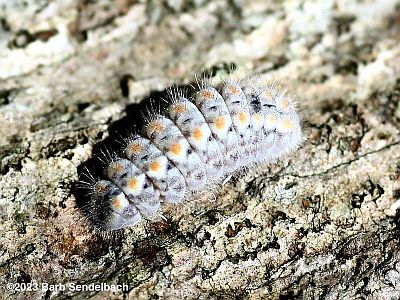New Jersey Butterfly Club
A chapter of the North American Butterfly Association (NABA)
Harvester
Feniseca tarquinius
Identification: Very small—1.2” (similar to Banded Hairstreak). Sexes similar. Above: FW and HW orange with wide, dark-brown borders. Below: Rusty-orange with many white-ringed, reddish-brown spots that look like watermarks. Mostly seen with wings closed.
NJ Status and Distribution: Resident. Uncommon and very local.

Habitat: Deciduous woods with American Beech (Fagus grandifolia), and stream and lake edges with alders (Alnus). Usually seen puddling on bare soil in the vicinity of water.
Flight Period: Three broods from late April to late October. Extreme dates: North Jersey 4/17-10/20; South Jersey 5/8—9/22.
Caterpillar Food Plants: None. The caterpillars feed on woolly aphids found on American Beech and alders, making this the only North American butterfly whose caterpillars are completely carnivorous.
Overwintering Stage: Probably pupa.
Good Locations: Harvester generally occurs in small colonies at reasonably stable locations: NJAS Scherman-Hoffman Sanctuary, Dismal Harmony NA, and Flatbrook-Roy WMA have persisted for years. In an apparent resurgence or expansion of this species beginning in 2022, new colonies were discovered (among numerous other places) at Kittatinny Valley SP, Hacklebarney SP, Thompson Park and Jamesburg Park Conservation Area (both Monroe Twp., Middlesex Co.), and Chestnut Branch Park (Mantua Twp., Gloucester Co.), and a colony not recorded since 2016 reappeared at Tatum Park (Middletown Twp., Monmouth Co.).
Comments: You never know when you will come across this rarity, but a trail through beech woods next to a rocky stream should get you looking. Most often seen taking moisture on bare soil, but individuals often have favorite basking/display spots on vegetation that they return to repeatedly. Adults do not nectar, but feed on aphid "honeydew," mud, sap, etc.

Hiawatha National Forest, MI, 7/15/11.

Tatum Park, Monmouth Co., NJ, 8/29/12.

Caterpillar feeding among wooly aphids on American Beech. For camouflage, it covers itself with the dried remains of aphids it has already eaten.

Caterpillar before disguising itself with aphid remains.

Pupa, Thompson Park, Monmouth Co., NJ, 8/18/22.